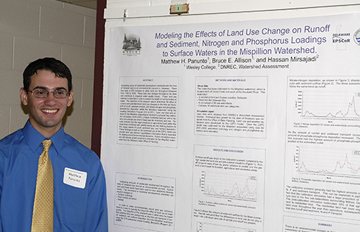| Barton |
Brown |
Dobbs |
Fischel |
Hailey |
| Panunto | Pearson | Reid | Stapley | Williamson |
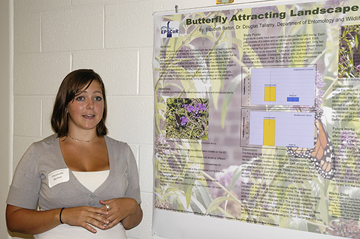 Butterfly Attracting Landscape Plants Elizabeth T. Barton and Douglas W. Tallamy Department od Entomology and Wildlife Ecology Many backyard gardeners are
enthralled with the idea of attracting butterflies into their yards and
increasing biodiversity in their gardens. The "butterfly gardens" these
people have created often include introduced species that do not
support the larval development of North American butterflies. Native
alternatives are available that attract the adult butterflies because
of nectar and support the entire life cycle of Lepidoptera. The
objective of the project is to compare quantitatively the
attractiveness of native and introduced perennial plants to adult
Lepidoptera. Sites were chosen on the UD farm. Data on butterfly
visitation (quantity and species variety) on the plant pairs will be
recorded in 15-minute periods during the pair's peak bloom time.
Supported by
Delaware EPSCoR, through National Science Foundation Grant EPS-0447610
|
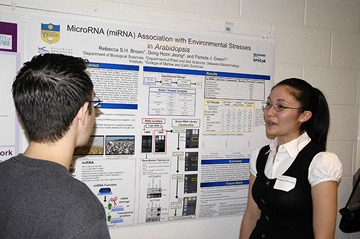 MicroRNA (miRNA) Association with Environmental Stresses in Arabidopsis Rebecca S. H. Brown, Dong-Hoon Jeong, and Pamela J. Green Department of Plant and Soil Science MicroRNAs (miRNA) are a type of
non-coding small RNA (smRNA) that
regulate gene expression at the post-transcriptional level by base
pairing with complementary sites in messenger RNA (mRNA), causing
either mRNA degradation or translational inhibition. The overall goal
of this project is to understand the relationship between miRNAs and
abiotic stresses in plants. How plants employ miRNAs to alter gene
expression when they encounter various stresses, like drought, cold,
submergence, and salinity, is of great agricultural importance. Plants
must develop sophisticated ways to cope with these stresses since they
are unable to evade them. We first utilized small RNA biogenesis
mutants such as dcl1, dcl2/3/4, or rdr2 to enrich specific small RNAs,
and then used these mutants to make smRNA libraries. We treated
Arabidopsis rdr2 seedlings with submergence, salt, and both submergence
and salt, while treating Arabidopsis rdr2 flowers with drought, salt,
and cold. Their low molecular weight RNA were isolated, and smRNA
libraries were constructed. We checked the quality of the libraries by
traditional cloning and sequencing. From these smRNA libraries, miRNA
expression will be analyzed by high-throughput sequencing by SBS
(sequencing by synthesis) and sent to a company (Illumina) or a
facility at the Delaware Biotechnology Institute to sequence, and then
for data mining by computational analysis. Potential miRNA candidates
will be identified and undergo validation. R.S.H.B was supported by
Delaware EPSCoR, through National Science Foundation Grant EPS-0447610
and the State of Delaware, and NSF grant MCB#0548569 to P.J.G. provided
research support.
|
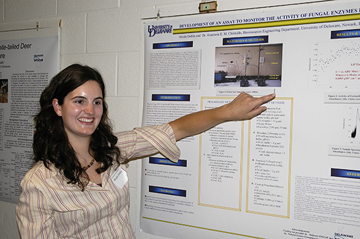 Development of an Assay to Monitor the Activity of Fungal Enzymes in Soil Nicole A Dobbs and Anastasia E. M. Chirnside Department of Animal Science White rot fungi, specifically
Phanerochaete chrysoporium, are able to produce non-stereo selective
enzymes that oxidize compounds present in pollutants and, therefore,
may be used for environmental remediation. Past research has
investigated the ability of the fungal enzymes, lignin peroxidases
(LiP) and manganese-dependent peroxidases (MnP), to degrade pesticides
and other compounds present in wastewater and the herbicides, atrazine
and alachlor, in contaminated soil. Although past studies have
successfully measured the percentage of compound degradation, there
still remain difficulties with measuring the enzyme activity after
application to the soil due to interacting compounds. The goal of this
research is to develop an assay and method to monitor the activity of
LiP and MnP within the soil over time. The fungi have been grown within
a packed-bed bioreactor, first supplied with growth media and then
starvation media which cause the fungi to begin the ligninolytic
activity. Once the fungi begin producing enzymes, the effluent will be
collected and applied to soil. The enzymes will be extracted from the
soil using the developed assay. The soil extract will be analyzed for
enzyme activity. LiP activity will be monitored by using a continuous
spectrophotometric assay that measures the oxidation of veratryl
alcohol to veratraldehyde at 310 nm. MnP activity will be monitored by
using a continuous spectrophotometric assay to measure the oxidation of
o-dianisidine to a colored-product at 460 nm. Future work will
evaluate the efficiency of this proposed method and continue examining
literature for other enzyme extraction methods from soil. Research
funded by Delaware EPSCoR, through National Science Foundation Grant
EPS-0447610 and the State of Delaware.
|
|
Sol-Gel Synthesis of Nano-Manganese Oxides: A Never Ending Mystery Jason Fischel, Matthew Fischel, Matthew Ginder-Vogel, and Donald L. Sparks Department of Plant and Soil Science Manganese(IV)
oxides represent one of the main redox
catalysts in the subsurface environment, while also extensively sorbing
a
number of anions and cations. Their wide-spread distribution in soil
combined
with their highly reactive surfaces allow manganese oxides, even in low
concentrations, to oxidize trace metals such as arsenic from arsenite
which is
fairly toxic and mobile to arsenate, a much less reactive and mobile
species.
Increasing the surface area of manganese oxides, in the form of
nanoparticles
has the potential to increase this reactivity drastically. Several
nano-manganese oxide species have been successfully synthesized using a
sol-gel
synthesis method. Variations in the synthesis technique such as
altering acid
concentration, Mn(II) salt, and the duration temperature of annealing
have
produced mixed oxidation state nano-Mn oxides. However, we hope that
this
technique will ultimately lead to a pure nano-Mn(IV) oxide mineral.
Synchrotron
X-ray diffraction (S-XRD) and scanning electron microscopy (SEM) were
used to
characterize the various manganese oxides. Research
funded by Delaware EPSCoR. |
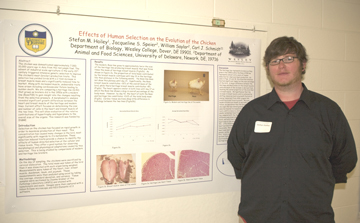 Effects of Human Selection on the Evolution of the Chicken Stefan M. Hailey1, Jacqueline S. Speier2, William Saylor2, Carl J. Schmidt2 1Department of Biology, Wesley College 2Department of Animal and Food Sciences, University of Delaware The chicken was domesticated
approximately 7,000-10,000 years ago in
Asia from the red jungle fowl. The advent of industrial scale
agriculture in the early 20th century triggered intensive genetic
selection to improve the chicken’s meat (broiler) production traits.
This selection has yielded birds with a 2 fold increase in breast
muscle mass and a significantly reduced time to market. Along with
increased muscle, undesirable traits have arisen including
cardiovascular failure leading to sudden death. We are comparing a
heritage line (IL50) that grows as broilers did in the 1950s with a
modern line (Ross708) to gain insight into the changes resulting from
the selective pressure. A morphometric analysis revealed significant
growth differences between the heart, breast muscle and liver of the
heritage and modern lines. Current effort focuses on determining the
size and number of cells in the heart and breast muscle of the two
lines. This will allow evaluation of the relative contributions of
hypertrophy and hyperplasia to the overall size of the organs. This
research was funded by INBRE.
|
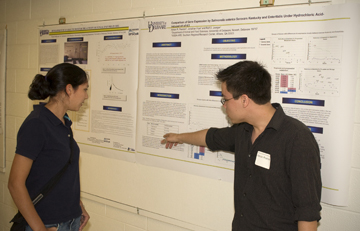 Comparison of Gene Expression by Salmonella enterica Serovars Kentucky and Enteritidis Under Hydrochloric Acid-induced pH of 4.5 Adrian R. Pearson and Rolf D. Joerger Department of Animal and Food Sciences Salmonella is one of the major
causes of food borne illness, and
serovars Typhimurium and Enteritidis among the more commonly isolated
serovars from the infected humans. Serovar Kentucky is only rarely
found in humans, but is the most prevalent serovar in chickens in the
United States. This serovar appears to be more sensitive to low pH
induced by hydrochloric acid, which could be one of the reasons for its
low infectivity in humans. The purpose of this study was to compare
gene expression under hydrochloric acid-induced conditions of a S.
enterica Kentucky and Enteritidis serovar. The two isolates were
grown
in rich medium of pH 8 until mid-logarithmic phase, then the pH of the
growth medium was lowered to 4.5 by addition of 10 N HCl. Total RNA was
isolated from the bacteria after a 10-min exposure to the acid
conditions using RNase Protect and the Qiagen RNeasy® Mini Kit. The
RNA
was dried under vacuum and sent to the USDA Agricultural Research
Service in Georgia for microarray hybridization The microarray data
showed a very similar gene expression profile in the two serovars, but
some operons were upregulated in the Kentucky isolate, but not in the
Enterititdis isolate. These operons included the pdu
(propanediol-utilization) genes, the cbi (vitamin B12 synthesis) genes,
putative hydrogenase gene STM1538 and asrABC (encoding anaerobic
sulfite reduction genes). The significance of these findings is
currently unknown and further gene expression studies will have to be
carried out to elucidate differences in acid response between
Salmonella serovars.
|
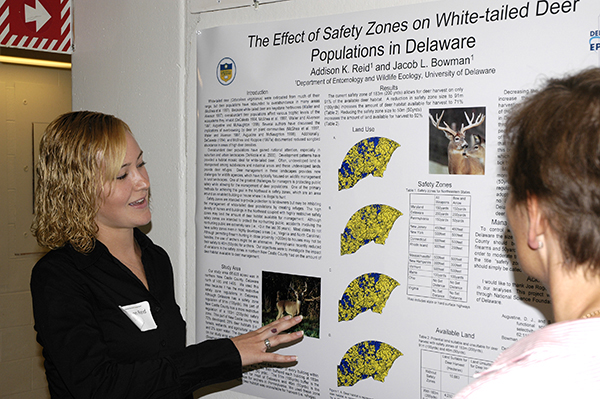 The Effect of Safety Zones on White-tailed Deer Populations in Delaware Addison K. Reid and Jacob L. Bowman Department of Entomology and Wildlife Ecology The suburban sprawl in the
northeastern states has created refuge areas
for white-tailed deer (Odocoileus virginianus) populations to
drastically increase. These refuges prevent deer population control by
limiting hunting access because of mandated safety zones. The balance
between public safety and deer population control is a challenge for
wildlife managers. Northern Delaware is a prime example of a densely
human populated area with a large deer population. We examined possible
impacts of altering safety zone size on the amount of land accessible
to hunting. Using an aerial photograph of New Castle County, Delaware
north of I-95 and I-495, a 183m (200yrds) buffer was established around
each inhabited building, which represents the size of the current
safety zone. Using this buffer we were able to quantify the current
land available for hunting. We altered the buffer size around each
building from 183m (200yrds) to 91m (100yrds) and 46m (50yrds) to
determine the total area of deer habitat accessible for harvest under
smaller safety zone sizes. By analyzing this data it was established
that by reducing the safety zone to a reasonable 91m (100yrds), 71% of
the land considered deer habitat would be available for harvest. By
reducing the safety zone distance wildlife managers could have a more
effective tool for controlling deer population and thus deer tick
related diseases and environmental damages due to deer browsing. This
study was supported by Delaware EPSCoR, through National Science
Foundation Grant EPS-0447610 and the State of Delaware
|
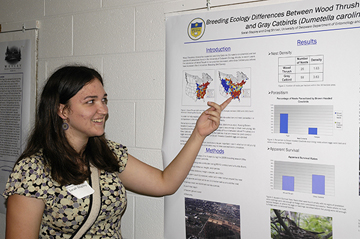 Comparison of Breeding Ecology Between Wood Thrushes and Gray Catbirds Sarah Stapley and Greg Shriver Department of Entomology and Wildlife Conservation The |
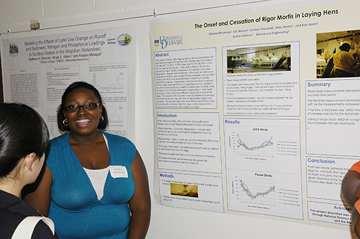 Onset and Cessation of Rigor Mortis In Laying Hens Kishana Williamson1, Mary Rankin1, Eric Benson2, Corinne Ciaverelli1, and Robert Alphin1 1Animal and Food Science Department, 2Bioresources Engineering Department, In the poultry industry, table
egg laying hens are used to produce the eggs that are bought in the
grocery store. Multiple layers are kept in one cage with 10,000 to
18,000 cages and 75,000-125,000 or more birds in a typical layer
house. In the poultry industry, the primary approach to highly
infectious diseases is surveillance, quarantine, depopulation,
disposal, and disinfection. When birds are infected or suspected
of infection, with a highly infectious disease, such as avian
influenza, the birds must be depopulated in order to prevent the spread
of the disease. Depopulation methods have been developed for
floor reared meat type birds, but caged layers remain a problem.
One of the critical questions is whether to depopulate the birds inside
the cages or to remove the birds prior to depopulation. After
death, during rigor mortis, it becomes difficult to remove the birds
from the cages. The purpose of this experiment was to determine the
average rigor mortis onset and relaxation time for depopulated caged
layer carcasses. This will help determine when are the most
efficient times for removing the carcasses from the cages, so that
disposal of the carcasses and disinfection of the facilities can begin.
This
study was supported by Delaware EPSCoR,
through National Science Foundation
Grant
EPS-0447610.
|
